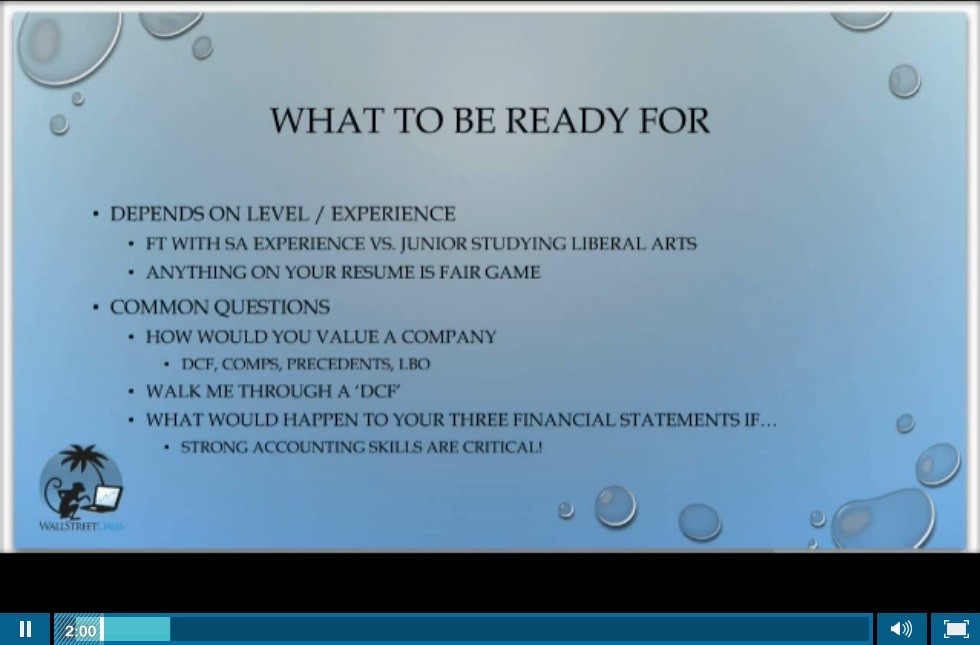Investment Banking Interview Wall Street Prep
Post on: 3 Июль, 2015 No Comment

The technical side of the investment banking interview is often comprised of valuation questions. capital markets questions, and accounting questions. When it comes to accounting, a favorite interview topic is the relationship between cash flows and net income. It is almost inevitable that a candidate will encounter questions like these (answers at end of article):
- If cash flows from operations are consistently lower than net income, what could this be an indication of? *
- Can a company showing increasing operating cash flows relative to net income be in financial distress? **
- Can a company showing negative cash flows be in great financial health? ***
Stated more broadly, these questions are all essentially asking:
- Whats the relationship between net income and cash flow?
This mornings Wall Street Journal provided us with a great illustration of this relationship. The Journal contained an article that explained how Avons ratio of cash flows to net income has been consistently low. and that it may be a harbinger of future problems:
analysts and accounting experts are particularly concerned about a long-term trend they say raises a red flag: The supply of cash Avon has available for such purposes as paying dividends, buying back stock and reducing debt has fallen short of its reported earnings for most of a decade. Avons stock has fallen more than 40% this year.
The problem here is not that net income has diverged from cash flows recently, rather, its that the divergence has been going on for nearly a decade.
Temporary differences between cash flows and accounting based profit (net income) are normal. For example, if Avon invoices customers, you would expect revenues to be greater than actual cash flows collected in certain periods.
In addition, since investments like the purchase of PP&E and other assets are depreciated over time, thereby impacting net income more smoothly than the one-time hit of a large purchase on the cash flow statement, large deviations in any given period are not necessarily nefarious.
The problem emerges when the difference is persistent over time. In our example, the invoiced customers must at some point pay in cash and so if you dont see the cash coming in during the next period, it might be a red flag. Similarly, a major PP&E investment in one period would certainly explain lower cash flows than net income in that particular period, but in the subsequent period, youd expect a swing back, since the net income is still capturing the depreciation expense from the prior-period purchase but there is no cash flow impact anymore.
There are many possible explanations for persistent divergences, most of which are not very good. For example, if a company is aggressively booking revenues from customers that ultimately dont pay, you could potentially see several years worth of higher revenue than cash receipts before the jig is up. Similarly, if capital investment made in the past is not generating sufficient returns, this can be somewhat obfuscated with deprecation assumptions that dont accurately capture the value of the investment in net income. A more sinister explanation is blatant earnings manipulation. In Avons case, all of the above may be the culprit:
The analysts and experts say wide and persistent gaps between the two figures typically indicate that a companys investments arent paying off very well or that its net income doesnt fully reflect depreciation and other costs of those investments. Net income amounts to revenue minus costs and the depreciation of a companys assets.
Since free cash flow and net income tend to balance out over the long run, persistent gaps between them can be a harbinger of asset write-downs or drop-offs in profit.
For students trying to break into investment banking, equity research, private equity, or asset management, ultimately the key to navigating through these types of questions is deeply understanding the relationship between the cash flow statement and the income statement.
* Avon is a perfect example of this type of scenario. Net income is high but cash flows are low. Reasons include: Low returns from PP&E investments and possible earnings manipulation. Read full article here .
** Yes, and this is not uncommon. As a company enters financial distress, it will hoard cash, not paying vendors, and collecting aggressively from suppliers. In the meantime, it will reduce capital investments, and not pay creditors.
*** Imagine Boeing secures several key long term contracts to deliver airplanes to major airliners. Depending on the agreement, cash flows from the airliners may come in after the company begins massive capital investments to service the contracts. This would show a poor negative cash flow position, despite an income statement that captures those expected revenues.














